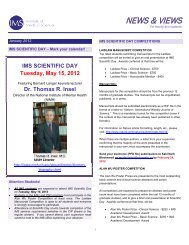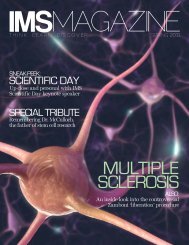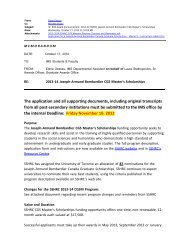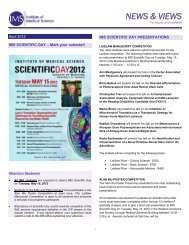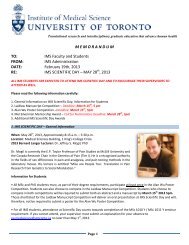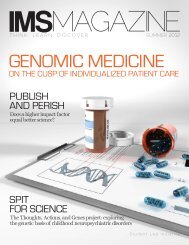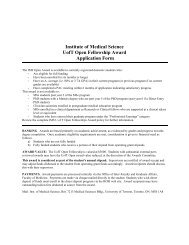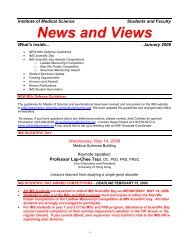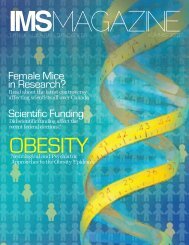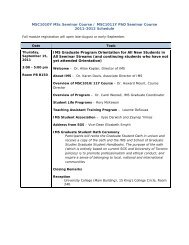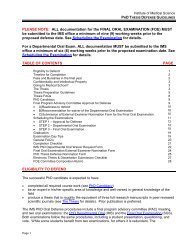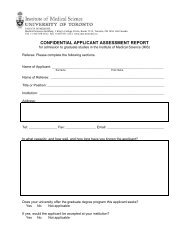Fall 2011 - Institute of Medical Science - University of Toronto
Fall 2011 - Institute of Medical Science - University of Toronto
Fall 2011 - Institute of Medical Science - University of Toronto
You also want an ePaper? Increase the reach of your titles
YUMPU automatically turns print PDFs into web optimized ePapers that Google loves.
FEATURE<br />
Photo courtesy <strong>of</strong> http://www.sxc.hu/photo/816375<br />
sensitivity to preventive agents, and surrogate<br />
molecular markers serving as intermediate<br />
end points. Despite all this, one has to<br />
recognize that the intrinsic heterogeneity <strong>of</strong><br />
any given study population makes nutritional<br />
studies difficult to perform. This is due to<br />
several factors including variations in individual<br />
lifestyles, complexity in food and food<br />
products, as well as the levels <strong>of</strong> consumption<br />
<strong>of</strong> such foods. Laboratory studies in<br />
preclinical animal models provide important<br />
guidelines in designing, conducting, and interpreting<br />
large studies in humans; however,<br />
complications and errors arise while translating<br />
data from animal studies to the clinical<br />
setting. This demonstrates the complexity<br />
in interpreting many <strong>of</strong> the contradictory<br />
reports that can confuse researchers, physicians<br />
and the public alike.<br />
Recent evidence highlights not only the role<br />
<strong>of</strong> dietary factors but also the inclusion <strong>of</strong><br />
physical activity as a key component in the<br />
development and progression <strong>of</strong> prostate<br />
cancer. Epidemiological and laboratory investigations<br />
indicate a negative relationship<br />
between regular exercise and the risk <strong>of</strong> certain<br />
malignancies, including prostate cancer.<br />
A recent review 11 has discussed the influence<br />
<strong>of</strong> physical activity on the carcinogenic<br />
process, where physical activity is dependent<br />
on energy contribution and the duration <strong>of</strong><br />
exercise. There are several probable biological<br />
mechanisms projected to explain the cancer-preventive<br />
effects <strong>of</strong> exercise, including<br />
changes in endogenous metabolic or sex hormone<br />
levels and growth factors, decreased<br />
obesity and central adiposity, alterations in<br />
immune functions, and alternations in reactive<br />
oxygen species (ROS). Interestingly,<br />
different levels <strong>of</strong> exercise may influence the<br />
ROS generation in different ways. In fact, it<br />
has been suggested that moderate levels <strong>of</strong><br />
exercise may have protective effects while too<br />
much exercise can be harmful. Thus, the determination<br />
<strong>of</strong> the optimal load <strong>of</strong> physical<br />
activity that can elicit cancer-preventive effects<br />
warrants further investigation.<br />
It is imperative to determine the best approach<br />
to keep prostate cancer at bay. Although<br />
much research still needs to be<br />
accomplished regarding the effect <strong>of</strong> micronutrients<br />
and macronutrients in prostate<br />
cancer progression, it is suggested that one<br />
can maintain overall good health by eating a<br />
well-balanced diet that is low in fat and carbohydrates,<br />
but rich in fruits and vegetables,<br />
and accompanied by moderate exercise.<br />
References<br />
1. Chan, J. M., et.al. Role <strong>of</strong> diet in prostate cancer development<br />
and progression. J. Clin. Oncol. 23: pp 8152–<br />
8160, 2005.<br />
2. Fleshner, NE., et al. Dietary Fat and Prostate Cancer.<br />
The Journal <strong>of</strong> Urology.171 (2): pp S19-S24, 2004.<br />
3. Venkateswaran, V., et al. Antioxidants block prostate<br />
cancer in Lady transgenic mice. Cancer Research. 64: pp<br />
5891-5896, 2004.<br />
4. Haddad, A., et al. Novel antiproliferative flavonoids<br />
induce cell cycle arrest in prostate cancer cell lines. Prostate<br />
Cancer Prostatic Diseases. 9 (1): pp 68-76, 2005.<br />
5. Venkateswaran, V. Selenium and Prostate Cancer:<br />
Biological Pathways and Biochemical Nuances. Cancer<br />
Therapy. 4: pp 73-80, 2006.<br />
6. Venkateswaran, V., et al. Early commencement <strong>of</strong><br />
micronutrients is beneficial in reducing the incidence<br />
<strong>of</strong> prostate cancer and increasing survival in the Lady<br />
transgenic model. Cancer Prevention Research. 2 (5): pp<br />
473-483, 2009.<br />
7. Venier N., et al. Chemopreventative Strategies in<br />
Prostate Cancer: Role <strong>of</strong> Dietary Agents. Invited Review.<br />
Current Cancer Therapy Reviews. 6: pp 308-316, 2010.<br />
8. Venkateswaran, V., et al. Diet and prostate cancer:<br />
mechanisms <strong>of</strong> action and implications for chemoprevention.<br />
Nature Reviews Urology. 7: pp 442-453, 2010.<br />
9. Huang, H.Y., et al. Customized diets for cancer prevention<br />
according to genetic polymorphisms: are we<br />
ready yet? Journal <strong>of</strong> the National Cancer <strong>Institute</strong>.<br />
98(22): 1590-1, 2006.<br />
10. Venkateswaran, V., et al. Association <strong>of</strong> diet induced<br />
hyperinsulinemia with accelerated growth <strong>of</strong> prostate<br />
cancer (LNCaP) xenografts. Journal <strong>of</strong> the National<br />
Cancer <strong>Institute</strong>. 99: pp 1793-800, 2007.<br />
11. Na, HK., et al. Effects <strong>of</strong> physical activity on cancer<br />
prevention. Ann. N.Y. Acad. Sci. Issue: Nutrition and<br />
Physical Activity in Aging, Obesity, and Cancer. 1229:<br />
176–183, <strong>2011</strong>.<br />
IMS MAGAZINE FALL <strong>2011</strong> PROSTATE CANCER | 18



